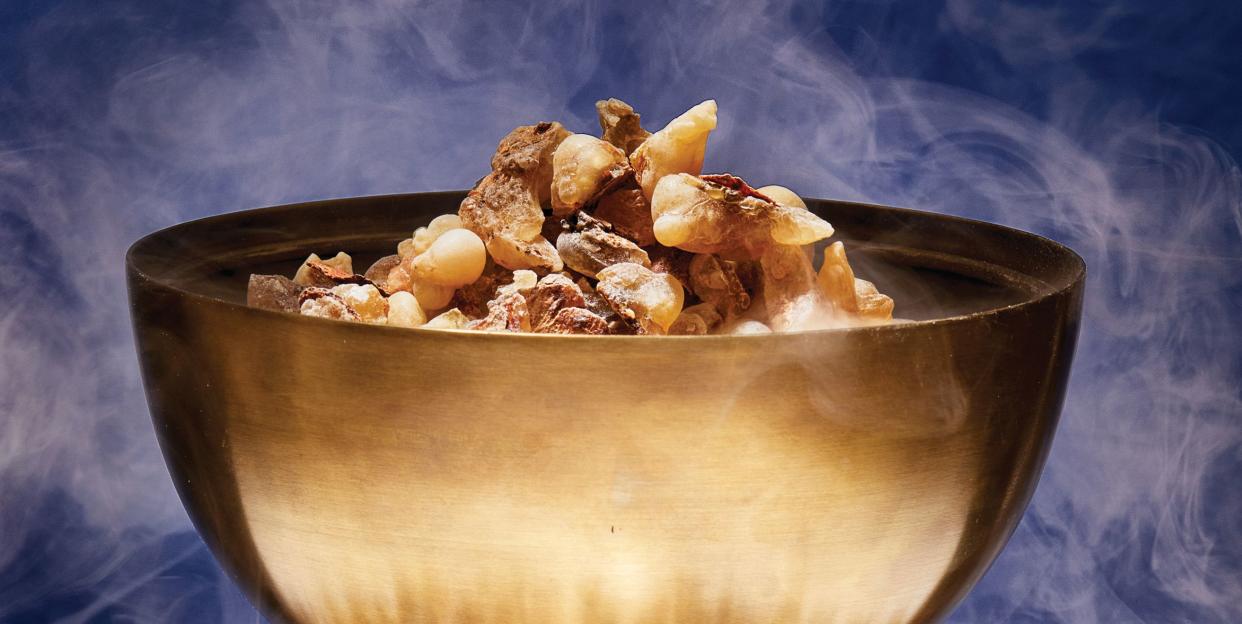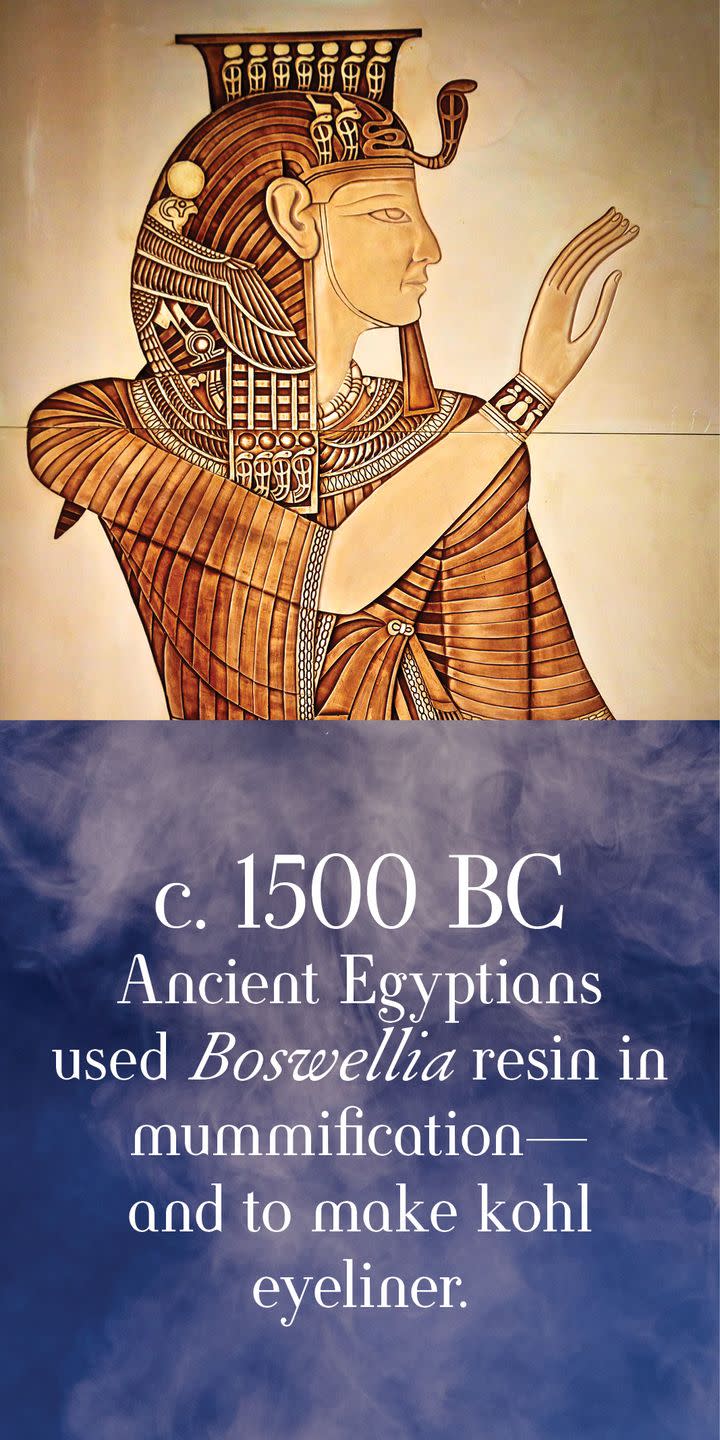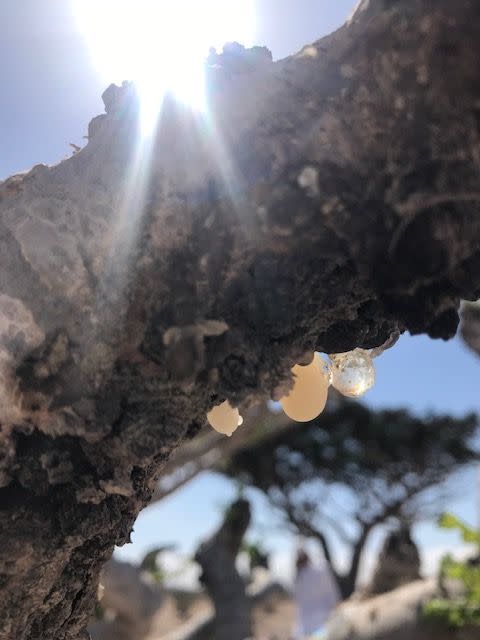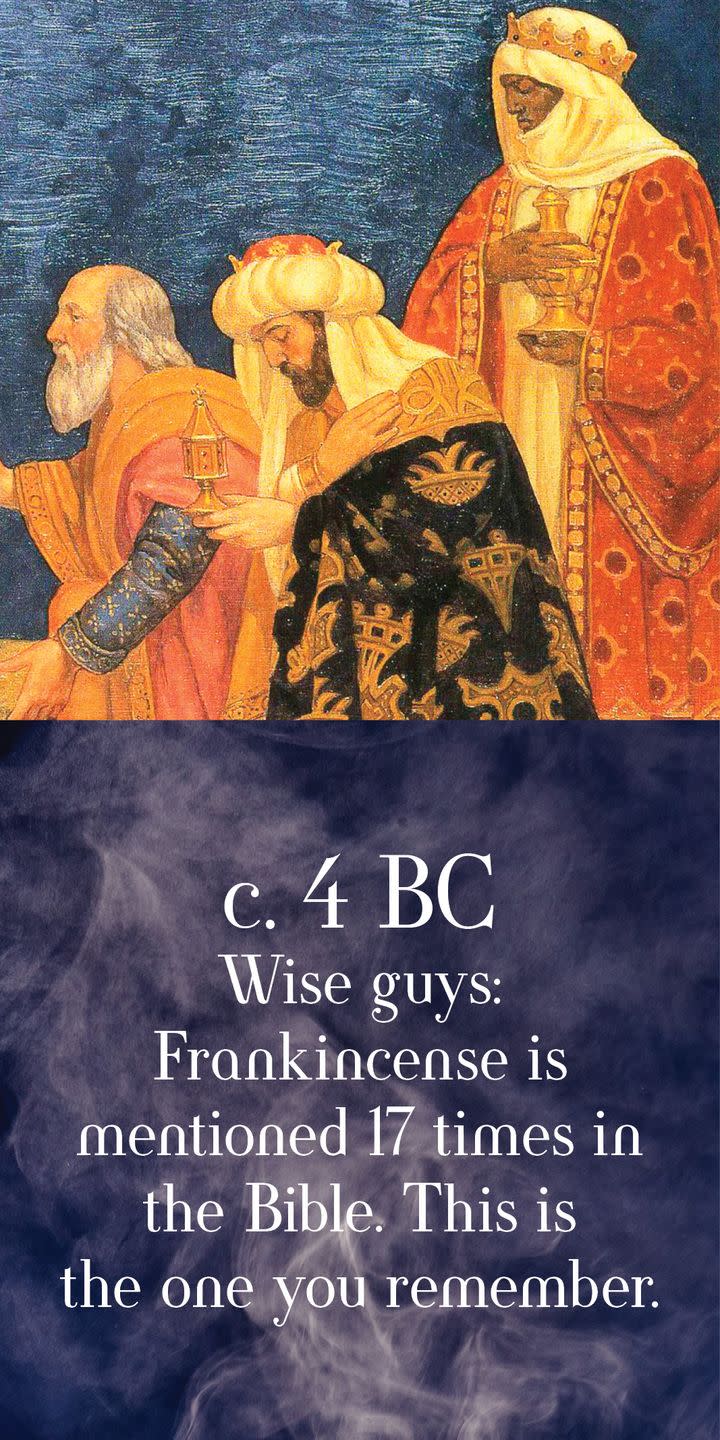Why Frankincense Is Suddenly So Smoking Hot

As trees go, Boswellia sacra is no beauty. It’s low, knobby, and gnarled, like Harry Potter’s Whomping Willow mixed with a baobab, a bonsai, or something out of Dr. Seuss. The environment in which it grows, too, is particularly punishing: It thrives in searing heat and relentless wind; its roots cling precariously to desert rocks where no other living thing can find purchase.
Yet the scent of the tree’s resin—that sublime and sacred substance known as frankincense—has enthralled human beings for millennia. Once as valuable as gold, it has fueled the growth of empires, sparked battles, sealed truces. It’s probably the most famous Christmas gift ever given. And, like many of the earth’s botanical treasures, we are uncomfortably close to losing it forever.

Standing in Wadi Dawkah, a frankincense grove at the heart of the Land of Frankincense (a UNESCO World Heritage Site) in Oman, facing an intense microdermabrasion of blowing sand, I feel like a time traveler. This region, in the province of Dhofar, near the border with Yemen, was once the nexus of the Incense Route, an ancient trading network of good-smelling stuff that stretched to Mesopotamia, the Mediterranean, Egypt, and India.
To the south lies the sunbaked husk of a port city called Sumhuram, supposed home of the Queen of Sheba, who wooed King Solomon some 3,000 years ago with piles of precious resin. To the north, archaeologists have uncovered traces of the lost city of Ubar, known as the Atlantis of the Sands, a frankincense commerce hub that, according to legend, grew so rich and corrupt that God sent a natural disaster to destroy it.
Just beyond that, in the evocatively named Empty Quarter, things go full-on Lawrence of Arabia: think 250,000 square miles of golden nothing, where dunes rise as high as 1,500 feet and can take three hours to climb.

My guide leads me to a 400-year-old tree and hands me a knife. Holding the blade sideways, I make a shallow but firm cut, through thin brown bark and bright green skin, scraping into the wood’s orange flesh. Within moments a constellation of small, milk-white droplets emerges, and it’s immediately clear why locals call frankincense beads “pearls of the desert.” They’re opalescent, luminous; I’d be tempted to string them on a necklace if they weren’t gummy to the touch.
In a few days, after they have hardened, a second and third cut, made a specific number of weeks apart, will yield larger, more valuable “tears,” the archetypal globs so cherished for their enchanting aroma.
Let’s take a moment to talk about that smell. Most Westerners’ first word association with frankincense is “churchy,” and the image includes cloaked priests waving smoking pendulums around stuffy cathedrals. But fresh frankincense is different. Sniffing it, I find, is to encounter something I have no vocabulary for. The adjectives I fumble for—woody, lemony, balsamic, spicy, camphorous, piney—seem woefully inadequate.
This shifting, elusive quality is surely what made the scent so mystical to the ancients, and it’s what makes distilled frankincense, also called olibanum, such a multifaceted jewel for perfumers. The secret sauce in countless iconic spritzes, from Chanel No. 5 to Guerlain’s Shalimar to Frédéric Malle’s Portrait of a Lady is…tree gunk.
“Frankincense can release a very wide range of effects, like an olfactive rainbow,” says perfumer Yann Vasnier, who based Cire Trudon’s Mortel, currently the French brand’s best-selling fragrance, on the note. “It’s somehow deep and light at the same time. It has citrus, spice, amber, smoke, but it also has a brightness to it.” For a modern scent alchemist, frankincense is a singularly versatile raw material that can dance with radiant florals as a top note just as effectively as it can impart a lasting, soft earthiness as the perfume dries down. "It's a wonderful base note that provides structure without being overwhelming," says Mindy Yang, founder of New York fragrance discovery studio Perfumarie. "It makes the whole formula more dynamic. You can't say that about other resins."
It’s also an idea as much as it is an ingredient. “It’s really the foundation of perfumers’ work,” Vasnier says. “When you use something with such a unique and powerful history in a fragrance, it adds mystery.”
Way back in the mists of time, frankincense was probably first burned for its antiseptic, insect-repelling qualities, but somewhere along the way it became infused with magic and wafted into a disparate array of cultures and religions. In Ayurveda it’s used to treat rheumatism and respiratory problems; in traditional Chinese medicine it’s said to relieve joint pain and balance emotions. The ancient Greeks believed its smoke could be used to divine the future; Christians saw those vapors as a visible representation of prayers rising to God. It’s in the Talmud, the Koran, and the Old Testament. To the Egyptians it was the sweat of the gods and an afterlife essential. When Howard Carter opened King Tut’s tomb in 1922, he didn’t just see, as his famous quote goes, “wonderful things,” he smelled them, too: The 3,000-year-old burial chamber contained jars of still-fragrant frankincense-spiked perfume oil.
Truly, frankincense was the OG eau. The word perfume comes from per fumare, or “through smoke” in Latin, a reference to the belief that to burn nice-smelling things was to call upon the gods. And franc encens in Old French meant the highest quality incense money could buy. So if you wanted to ensure a metaphysical direct-dial to your deity, bewitching Boswellia was your go-to.

“If perfume were analogous to literature, frankincense would be one of the myths,” says David Seth Moltz of niche fragrance brand D.S. & Durga. “We’ve been using it longer than anything else. It’s one of the more badass perfume materials. It has spiritual associations, and kind of a death ritual vibe.”
“Frankincense connects you to a global, spiritual, historical, luxurious past,” says natural perfumer and author Mandy Aftel. “Even if you don’t know it, when you smell it for the first time you have this extraordinary experience with it. It has this resonance that speaks to everyone in some way.”
Maybe that’s why, when a study was published last summer in Nature Sustainability predicting that half of the world’s intact frankincense forests could be gone within 20 years, alarm bells went off. “Could This Be the End of Frankincense?” asked the New York Times; “Bad News for Christmas” trumpeted countless blogs. This stuff is epoch-spanning, epic. Literally biblical. Is it really on the precipice of extinction?
There are 20 species of Boswellia in the world, only five of which produce frankincense. Oman’s Boswellia sacra is considered the crème de la crème, but it’s exported in extremely small quantities; the vast majority of frankincense sold commercially comes from Ethiopia, Somalia, and Sudan. A number of things threaten these plants: climate change, land clearing for livestock, and decimation from warfare. But the biggest antagonist is overharvesting: Trees are being tapped too frequently, and because the ecosystem is stressed, natural regeneration has practically zeroed out.

Why is this happening? Frankincense is used in a lot more than just incense and perfume. Its anti-inflammatory properties make it a potent player in skincare (you’ll see it in luxe face oils from Sonya Dakar, Uma, and True Botanicals, to name a few), and studies keep proving it to be a medical marvel with clinical potential to treat arthritis, gastrointestinal issues, and, yes, even cancer.
The recent spike in demand, though, has been sparked largely by the Goop generation’s desire for essential oils. Frankincense’s woo-woo credentials make it candy for meditating wellness warriors (it activates your crown chakra, evidently), and there’s legitimate science behind its effects: A chemical component of Boswellia has been found to have significant anti-anxiety and antidepressive effects, at least in mice.
For some people it may still be the signature scent of High Mass, but for others it’s now l’eau de spa: the first thing you sniff when sinking into a massage bed or crossing the threshold of Manhattan’s buzzy new private club The Well, where the air is infused with a frankincense aroma custom crafted by Michelle Gagnon, of premium essential oil house Enfleurage.
“For a long time, things were fairly stable, and then aromatherapy got into the game,” says Dominique Roques, the head of natural ingredient procurement for the fragrance house Firmenich. “That’s not -finger-pointing, it’s just fact. The problem was that these guys needed so much in such a short time that they did things wrong. They went too fast, pushed too hard.”
“When a tree is cut too much, it bleeds to death, or it gets infections that kill it,” says Frans Bongers, an ecologist at Wageningen University and Research in the Netherlands who co-authored the Nature Sustainability study. “The drive for resin is so high that people are just trying to get as much of it as possible without any consideration for the health of the tree.” And while the ill-fated population of trees examined in his study (Boswellia papyrifera, used primarily for incense) was limited to Ethiopia, Bongers says the problem seems to be endemic to all -frankincense-producing regions.
There is some good news. First of all, the biggest players in fine fragrance—including International Flavors & Fragrances, Givaudan, and Firmenich—have sustainability programs in place for olibanum, as they do for most natural ingredients needed to make perfumes. “There’s also a new and incredible pressure coming from consumers,” Roques says. “If you’re buying or using vanilla from Madagascar, for example, they want to be sure there aren’t slave children somewhere in the supply chain. They’re putting pressure on us to make sure that we’re sourcing these ingredients responsibly.”

Consumer vigilance is driving change in the aromatherapy world as well, says Bongers, who has been fielding calls from companies seeking counsel on frankincense best practices. “They have millions of people buying these products for health reasons, or for connecting to nature, or for religious purposes—and these people are asking questions. Everyone is seeing how important it is to get this right in the long run.”
Frankincense production is difficult to regulate, since most of the trees are on tribal land, but even so Bongers is seeing a move toward farmer-run organizations, as well as the establishment of plantations. “It’s all about training people to treat these trees well,” he says. “The most important word here is care.”
As more money is invested in fair trade practices and proper harvesting, the price of frankincense is likely to rise, perhaps quite dramatically. This is as it should be, says Aftel, who displays rare botanicals in her Berkeley, California Archive of Curious Scents. “I think everything, honestly, that’s beautiful and rich and comes from nature should be treated as a luxury.”
If Oman is a microcosm of what can happen when a country starts to take care of a dwindling resource, it’s setting a pretty good example. When the UNESCO site at Wadi Dawkah was established in 2000, only about 1,200 frankincense trees were still growing on that land. Since then thousands more have been planted, and the goal is to reach 10,000 within the site’s protected environs. An irrigation system has been installed to help saplings along, but there are also wild trees flourishing beyond the perimeter fence. The camels that wander by and eat their leaves, I’m told, have especially delicious milk.

The Greek historian Herodotus wrote in 450 BC that this part of southern Arabia “exhales an odor marvelously sweet.” Not much has changed—only in lieu of dromedary caravans on the dusty Incense Route there are six-lane highways with billboards bearing photos of Pharrell that say “Don’t Text and Drive.” Frankincense hangs in the air wherever you go—it burns in hotel lobbies and shopping malls; it even wafts from the clothing of passersby, thanks to the Omani custom of draping laundry over hunks of smoldering resin. Locals chew the resin as gum, infuse it into water, and burn it in their homes every evening to ward off bad luck. It’s embedded in the fabric of their lives—and, like so many wondrous things that have become over-familiar, it has been taken for granted.
In 1983, the late Sayyid Hamad bin Hamood Al Busaidi founded the luxury fragrance house Amouage, with the mission to celebrate the Middle East as the birthplace of perfume, and frankincense as Oman’s crown jewel. The fragrances, which are among the most expensive in the world, are exquisite in every way. They mature in vats for two months before being bottled, and they’re sold in heavy glass bottles adorned with Swarovski crystal–studded caps shaped like a khanjar, an ancient Omani curved dagger, or like the dome of the lavish Grand Mosque in the capital city, Muscat. The company was even given the royal stamp of approval by the perfume-loving sultan, Qaboos bin Said al Said.
For many years Amouage stopped using Omani Boswellia sacra in favor of a synthetic replacement, but now that Oman’s government has stepped up its preservation efforts, and awareness of frankincense’s plight has reignited a patriotic fervor for the stuff, the brand is introducing sustainably produced local olibanum into its scents. “I think many Omanis had forgotten how special our frankincense is,” Amouage fragrance oil specialist Musallam Al Aasmi says. “But it has become very clear. We have something unique and precious, something that we cannot allow to disappear.”
“Omani frankincense is the holy grail,” says natural perfumer Douglas Little, who used it in Smudge, a smoky, bad vibe–banishing scent from his brand Heretic. The finest, most highly sought-after grade available, green hojari, emits the most transcendent expression of the resin’s aroma. “It can be cost-prohibitive, but it has a depth and a woodiness, a richness and a texture that are just sublime.”
Just before I leave Oman, Al Aasmi distills a fresh batch of hojari at the Amouage factory and gives me some in a small vial. With one sniff I’m back among those crooked trees, hearing their branches whisper in the wind and smelling their ineffable, living scent. It’s going to take work to ensure that frankincense survives in the long term, but among the endless legends attached to this strange little tree, there’s one I keep thinking about: When the mythical phoenix rose from the ashes, it built its nest from frankincense twigs and fed on the tree’s gummy resin. Rebirth and endurance. Significant, no?
Frankincense provides an olfactory link to where we came from, but it’s also a pretty powerful symbol of our society’s current position at an environmental crossroads. This may be our only chance to save a plant with its greatest potential still untapped, so to speak. “Frankincense is very ancient, yes,” Al Aasmi says. “But I think it still has so many more stories to tell, so many more secrets for us to discover. It is time to stop thinking about it as something from the past, and instead think about it as something that could very well change our future.”
Photograph at top by Jeffrey Westbrook, styled by Miako Katoh. Apparatus Censer Incense Burner ($820).
This story appears in the December 2019/January 2020 issue of Town & Country.
SUBSCRIBE NOW
You Might Also Like

